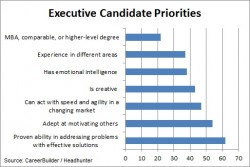 When employers look for senior people — and 31 percent will be, a new survey says — the evidence is they’re all looking for the same qualities. Industry experience is important; so is proven problem solving.
When employers look for senior people — and 31 percent will be, a new survey says — the evidence is they’re all looking for the same qualities. Industry experience is important; so is proven problem solving.
Nowhere on the list of qualities a CareerBuilder survey reported as important to employers was craziness listed. Perhaps that trait was covered by the “Is creative” characteristic that 43 percent of the respondents look for in a new executive.
But I don’t believe crazy creative is what the surveyed hiring managers and HR pros were intending. I suspect that what the 31 percent of them who expect to be filling executive positions in the next several months will look for, will be the disciplined creativity of a Norman Podhoretz.
Look at the important traits on the CareerBuilder list and they seem respectable enough: speed and agility is important to 47 percent of the respondents; 62 percent want proven ability in problem solving. Ability to motivate and emotional intelligence make the list.
Then you look at the makeup of their executive teams. The survey found 22 percent of the companies have no women executives; 41 percent have no African Americans, Hispanics, Asians, LGBTs, disabled, or other, similar individuals.
What that seems to say, is that employers want executives who think outside the box, just not too far outside. And they are most comfortable with executives who look like them.
Which brings me to Dan Oswald. “So,” asks he in a sort of pean to Steve Jobs, “my question to you as a manager is this, “Who are your crazy ones?”
“So often, as managers, we want everyone to conform. We want our people to fall into line and not make waves. But often the good ones challenge the status quo and in doing so ruffle a few feathers.”
Jobs so ruffled feathers that he was ousted as CEO of the company he founded. He ignored convention, and dropped out of college so he could study what he wanted. It was, he told a Stanford graduating class years later, “beautiful, historical, artistically subtle in a way that science can’t capture, and I found it fascinating.”
“None of this had even a hope of any practical application in my life,” he said, until years later when Apple built the Macintosh and opened the world to desktop publishing.
What does this have to do with hiring business executives? Says Oswald, author of the Oswald Letter and CEO of HR-focused BLR:
Look for those who think differently. Find those misfits, rebels, and troublemakers and figure out how you can best use the talents they have…
They might be hard to manage at times — maybe all of the time. They may be disrespectful or unorthodox, but they can and will perform. It’s your job to figure out how to best use their unique talents to the benefit of the organization. Don’t dismiss them for being different, embrace it!